Flexible Nanofiber Pressure Sensors with Hydrophobic Properties for Wearable Electronics
Abstract
1. Introduction
2. Experimental
2.1. Materials
2.2. Preparation of BC/ZnO Aerogel
2.3. Preparation of BC/ZnO Aerogel-Based Pressure Sensors
2.4. Characterization
3. Results and Discussion
3.1. Microstructure and Mechanical Properties of Aerogels
3.2. Sensing Performance and Mechanism
3.3. Applications for Pressure Sensors
3.4. Hydrophobic Properties of Pressure Sensors
4. Conclusions
Author Contributions
Funding
Institutional Review Board Statement
Informed Consent Statement
Data Availability Statement
Conflicts of Interest
References
- Shu, Q.; Pang, Y.; Li, Q.; Gu, Y.; Liu, Z.; Liu, B.; Li, J.; Li, Y. Flexible resistive tactile pressure sensors. J. Mater. Chem. A 2024, 12, 9296–9321. [Google Scholar] [CrossRef]
- Gao, Y.; Xiao, T.; Li, Q.; Chen, Y.; Qiu, X.; Liu, J.; Bian, Y.; Xuan, F. Flexible microstructured pressure sensors: Design, fabrication and applications. Nanotechnology 2022, 33, 322002. [Google Scholar] [CrossRef] [PubMed]
- Shi, Z.; Meng, L.; Shi, X.; Li, H.; Zhang, J.; Sun, Q.; Liu, X.; Chen, J.; Liu, S. Morphological engineering of sensing materials for flexible pressure sensors and artificial intelligence applications. Nano-Micro Lett. 2022, 14, 141. [Google Scholar] [CrossRef] [PubMed]
- Kim, J.-S.; So, Y.; Lee, S.; Pang, C.; Park, W.; Chun, S. Uniform pressure responses for nanomaterials-based biological on-skin flexible pressure sensor array. Carbon 2021, 181, 169–176. [Google Scholar] [CrossRef]
- Qin, R.; Nong, J.; Wang, K.; Liu, Y.; Zhou, S.; Hu, M.; Zhao, H.; Shan, G. Recent advances in flexible pressure sensors based on MXene materials. Adv. Mater. 2024, 2312761. [Google Scholar] [CrossRef] [PubMed]
- Hosseini, E.S.; Manjakkal, L.; Shakthivel, D.; Dahiya, R. Glycine–chitosan-based flexible biodegradable piezoelectric pressure sensor. ACS Appl. Mater. Interfaces 2020, 12, 9008–9016. [Google Scholar] [CrossRef] [PubMed]
- Asghar, W.; Li, F.; Zhou, Y.; Wu, Y.; Yu, Z.; Li, S.; Tang, D.; Han, X.; Shang, J.; Liu, Y. Piezocapacitive flexible E-skin pressure sensors having magnetically grown microstructures. Adv. Mater. Technol. 2020, 5, 1900934. [Google Scholar] [CrossRef]
- Meng, K.; Xiao, X.; Wei, W.; Chen, G.; Nashalian, A.; Shen, S.; Xiao, X.; Chen, J. Wearable pressure sensors for pulse wave monitoring. Adv. Mater. 2022, 34, 2109357. [Google Scholar] [CrossRef] [PubMed]
- Chen, W.; Yan, X. Progress in achieving high-performance piezoresistive and capacitive flexible pressure sensors: A review. J. Mater. Sci. Technol. 2020, 43, 175–188. [Google Scholar] [CrossRef]
- Cao, M.; Su, J.; Fan, S.; Qiu, H.; Su, D.; Li, L. Wearable piezoresistive pressure sensors based on 3D graphene. Chem. Eng. J. 2021, 406, 126777. [Google Scholar] [CrossRef]
- Qi, Z.; Zhang, T.; Zhang, X.-D.; Xu, Q.; Cao, K.; Chen, R. MXene-based flexible pressure sensor with piezoresistive properties significantly enhanced by atomic layer infiltration. Nano Mater. Sci. 2022, 5, 439–446. [Google Scholar] [CrossRef]
- He, J.; Zhang, Y.; Zhou, R.; Meng, L.; Chen, T.; Mai, W.; Pan, C. Recent advances of wearable and flexible piezoresistivity pressure sensor devices and its future prospects. J. Mater. 2020, 6, 86–101. [Google Scholar] [CrossRef]
- Pan, H.; Lee, T.W. Recent progress in development of wearable pressure sensors derived from biological materials. Adv. Healthc. Mater. 2021, 10, 2100460. [Google Scholar] [CrossRef] [PubMed]
- Seo, J.; Li, S.; Tsogbayar, D.; Hwang, T.; Park, J.; Ko, E.; Park, S.-J.; Yang, C.; Lee, H.S. Advanced multiparallel-connected piezoresistive physical sensors: Elevating performance reliability of flexible strain and pressure sensors. ACS Appl. Mater. Interfaces 2024, 16, 22229–22237. [Google Scholar] [CrossRef] [PubMed]
- Liu, J.; Zhang, X.; Liu, J.; Liu, X.; Zhang, C. 3D Printing of Anisotropic Piezoresistive Pressure Sensors for Directional Force Perception. Adv. Sci. 2024, 2309607. [Google Scholar] [CrossRef] [PubMed]
- Cheng, W.; Tee, B.C.K. Designing air-entrapment interfaces for near-ideal pressure sensors. Nat. Mater. 2023, 22, 1290–1291. [Google Scholar] [CrossRef] [PubMed]
- Ding, Y.; Xu, T.; Onyilagha, O.; Fong, H.; Zhu, Z. Recent advances in flexible and wearable pressure sensors based on piezoresistive 3D monolithic conductive sponges. ACS Appl. Mater. Interfaces 2019, 11, 6685–6704. [Google Scholar] [CrossRef] [PubMed]
- Karagiorgis, X.; Khandelwal, G.; Beniwal, A.; Chirila, R.; Skabara, P.J.; Dahiya, R. Polydimethylsiloxane foam-based fully 3D printed soft pressure sensors. Adv. Intell. Syst. 2023, 2300367. [Google Scholar] [CrossRef]
- Yang, H.; Shang, J.C.; Wang, W.F.; Yang, Y.F.; Yuan, Y.N.; Lei, H.S.; Fang, D.N. Polyurethane sponges-based ultrasensitive pressure sensor via bioinspired microstructure generated by pre-strain strategy. Compos. Sci. Technol. 2022, 221, 109308. [Google Scholar] [CrossRef]
- Liu, W.; Liu, N.; Yue, Y.; Rao, J.; Cheng, F.; Su, J.; Liu, Z.; Gao, Y. Piezoresistive pressure sensor based on synergistical innerconnect polyvinyl alcohol nanowires/wrinkled graphene film. Small 2018, 14, 1704149. [Google Scholar] [CrossRef]
- Tao, L.Q.; Zhang, K.N.; Tian, H.; Liu, Y.; Wang, D.Y.; Chen, Y.Q.; Yang, Y.; Ren, T.L. Graphene-paper pressure sensor for detecting human motions. ACS Nano 2017, 11, 8790–8795. [Google Scholar] [CrossRef] [PubMed]
- Zhang, M.; Fang, S.; Nie, J.; Fei, P.; Aliev, A.E.; Baughman, R.H.; Xu, M. Self-powered, electrochemical carbon nanotube pressure sensors for wave monitoring. Adv. Funct. Mater. 2020, 30, 2004564. [Google Scholar] [CrossRef]
- Basarir, F.; Madani, Z.; Vapaavuori, J. Recent advances in silver nanowire based flexible capacitive pressure sensors: From structure, fabrication to emerging applications. Adv. Mater. Interfaces 2022, 9, 2200866. [Google Scholar] [CrossRef]
- Navale, Y.H.; Navale, S.T.; Ramgir, N.S.; Stadler, F.J.; Gupta, S.K.; Aswal, D.K.; Patil, V.B. Zinc oxide hierarchical nanostructures as potential NO2 sensors. Sens. Actuators B Chem. 2017, 251, 551–563. [Google Scholar] [CrossRef]
- Wahid, K.A.; Lee, W.Y.; Lee, H.W.; Teh, A.S.; Bien, D.C.S.; Abd Azid, I. Effect of seed annealing temperature and growth duration on hydrothermal ZnO nanorod structures and their electrical characteristics. Appl. Surf. Sci. 2013, 283, 629–635. [Google Scholar] [CrossRef]
- Prete, P.; Lovergine, N.; Tapfer, L. Nanostructure size evolution during Au-catalysed growth by carbo-thermal evaporation of well-aligned ZnO nanowires on (100)Si. Appl. Phys. A 2007, 88, 21–26. [Google Scholar] [CrossRef]
- Reddy, I.N.; Reddy, C.V.; Sreedhar, M.; Cho, M.; Shim, J.; Reddy, V.R.; Choi, C.J.; Kim, D. Effect of seed layers (Al, Ti) on optical and morphology of Fe-doped ZnO thin film nanowires grown on Si substrate via electron beam evaporation. Mater. Sci. Semicond. Process. 2017, 71, 296–303. [Google Scholar] [CrossRef]
- Li, Y.; Jiang, D.; An, Y.; Chen, W.; Huang, Z.; Jiang, B. Wearable flexible pressure sensors: An intriguing design towards microstructural functionalization. J. Mater. Chem. A 2024, 12, 6826–6874. [Google Scholar] [CrossRef]
- Maharjan, S.; Samoei, V.K.; Jayatissa, A.H.; Noh, J.-H.; Sano, K. Knittle pressure sensor based on graphene/polyvinylidene fluoride nanocomposite coated on polyester fabric. Materials 2023, 16, 7087. [Google Scholar] [CrossRef]
- Yan, J.; Ma, Y.; Jia, G.; Zhao, S.; Yue, Y.; Cheng, F.; Zhang, C.; Cao, M.; Xiong, Y.; Shen, P.; et al. Bionic MXene based hybrid film design for an ultrasensitive piezoresistive pressure sensor. Chem. Eng. J. 2022, 431, 133458. [Google Scholar] [CrossRef]
- Xia, Y.; Huang, P.; Lin, X.; Wu, L.; Li, K.; Gao, C.; Zhong, G. The piezoresistive pressure sensors based on ITO nanocrystalline-plant fiber composite. Sci. China Mater. 2023, 66, 3922–3930. [Google Scholar] [CrossRef]
- Qin, Y.; Gao, B.; Zhou, C. Highly sensitive and breathability flexible piezoresistive pressure sensor based on xylon. Adv. Mater. Technol. 2024, 2400035. [Google Scholar] [CrossRef]
- Zhang, D.; Zhang, X.; Li, X.; Wang, H.; Sang, X.; Zhu, G.; Yeung, Y. Enhanced piezoelectric performance of PVDF/BiCl3/ZnO nanofiber-based piezoelectric nanogenerator. Eur. Polym. J. 2022, 166, 110956. [Google Scholar] [CrossRef]
- Li, L.; Chang, K.-C.; Lin, X.; Zhang, R.; Lou, J.-H. Insulating Property Improvement of Polyimide in Devices by Low-Temperature Supercritical Fluids. Adv. Electron. Mater. 2019, 5, 1900580. [Google Scholar] [CrossRef]
- Ardekani, S.R.; Aghdama, A.S.R.; Nazari, M.; Bayat, A.; Saievar-Iranizad, E. A new approach for preparation of semi-transparent superhydrophobic coatings by ultrasonic spray hydrolysis of methyltrimethoxysilane. Prog. Org. Coat. 2019, 135, 248–254. [Google Scholar] [CrossRef]
- Zhang, Z.; Sebe, G.; Rentsch, D.; Zimmermann, T.; Tingaut, P. Ultralightweight and flexible silylated nanocellulose sponges for the selective removal of oil from water. Chem. Mater. 2014, 26, 2659–2668. [Google Scholar] [CrossRef]
- Wang, P.; Bian, R.; Meng, Q.; Liu, H.; Jiang, L. Bioinspired dynamic wetting on multiple fibers. Adv. Mater. 2017, 29, 1703042. [Google Scholar] [CrossRef] [PubMed]
- Zhou, S.; You, T.; Zhang, X.; Xu, F. Superhydrophobic cellulose nanofiber-assembled aerogels for highly efficient water-in-oil emulsions separation. ACS Appl. Nano Mater. 2018, 1, 2095–2103. [Google Scholar] [CrossRef]
- Zhang, J.; Cheng, Y.; Xu, C.; Gao, M.; Zhu, M.; Jiang, L. Hierarchical interface engineering for advanced nanocellulosic hybrid aerogels with high compressibility and multifunctionality. Adv. Funct. Mater. 2021, 31, 2009349. [Google Scholar] [CrossRef]
- Jin, W.; Yu, Z.; Hu, G.; Zhang, H.; Huang, F.; Gu, J. Effects of three-dimensional circular truncated cone microstructures on the performance of flexible pressure sensors. Materials 2022, 15, 4708. [Google Scholar] [CrossRef]
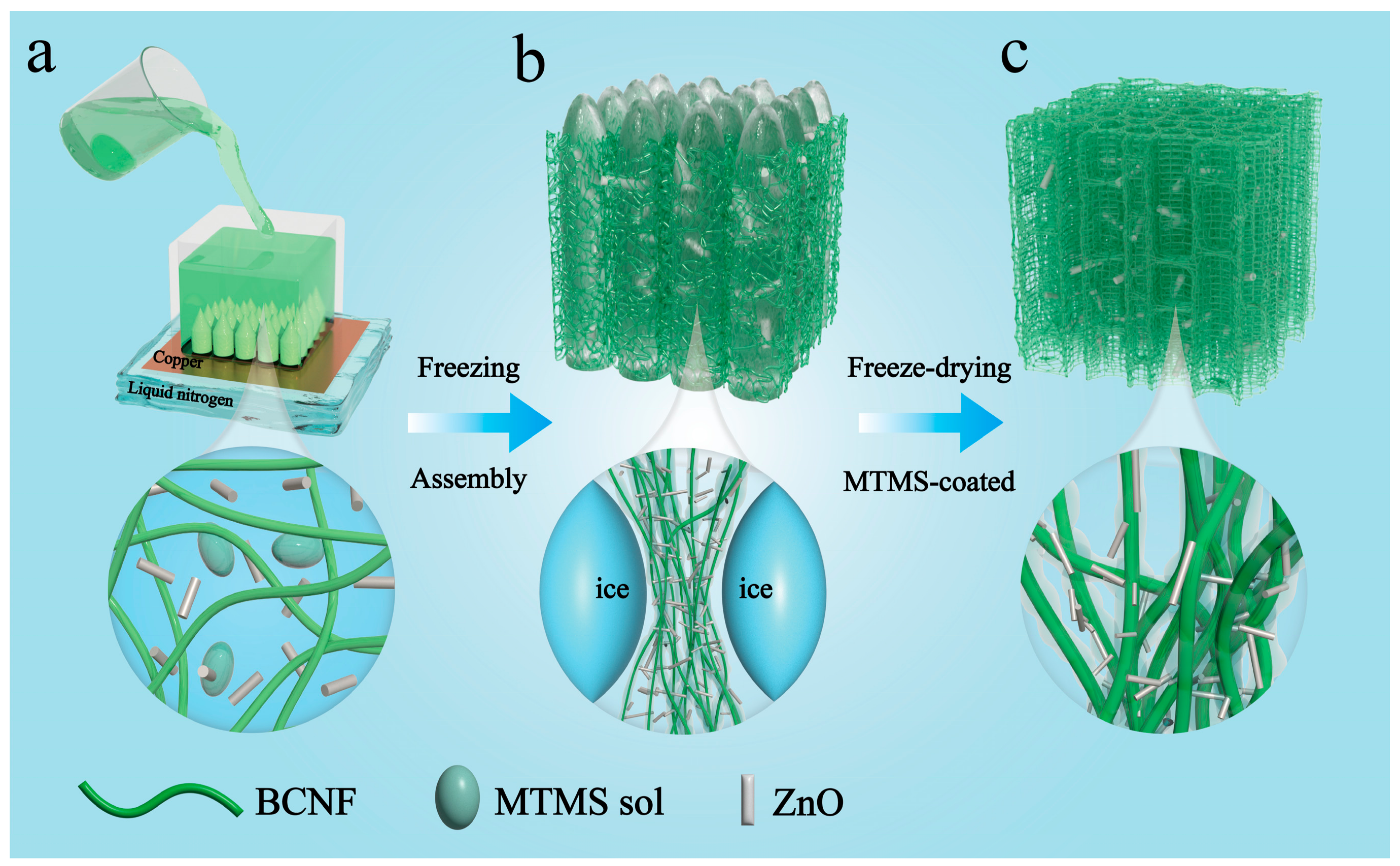
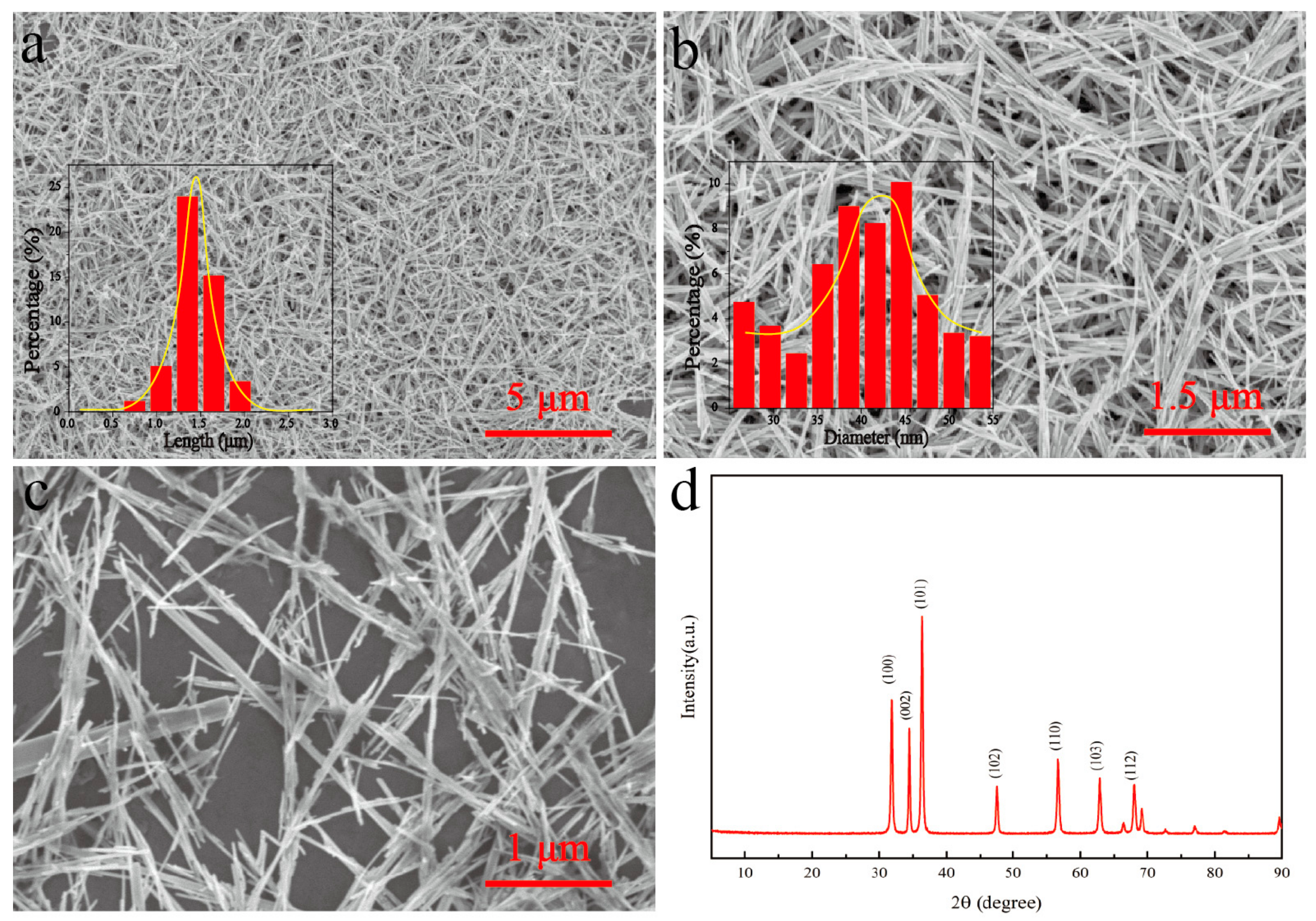

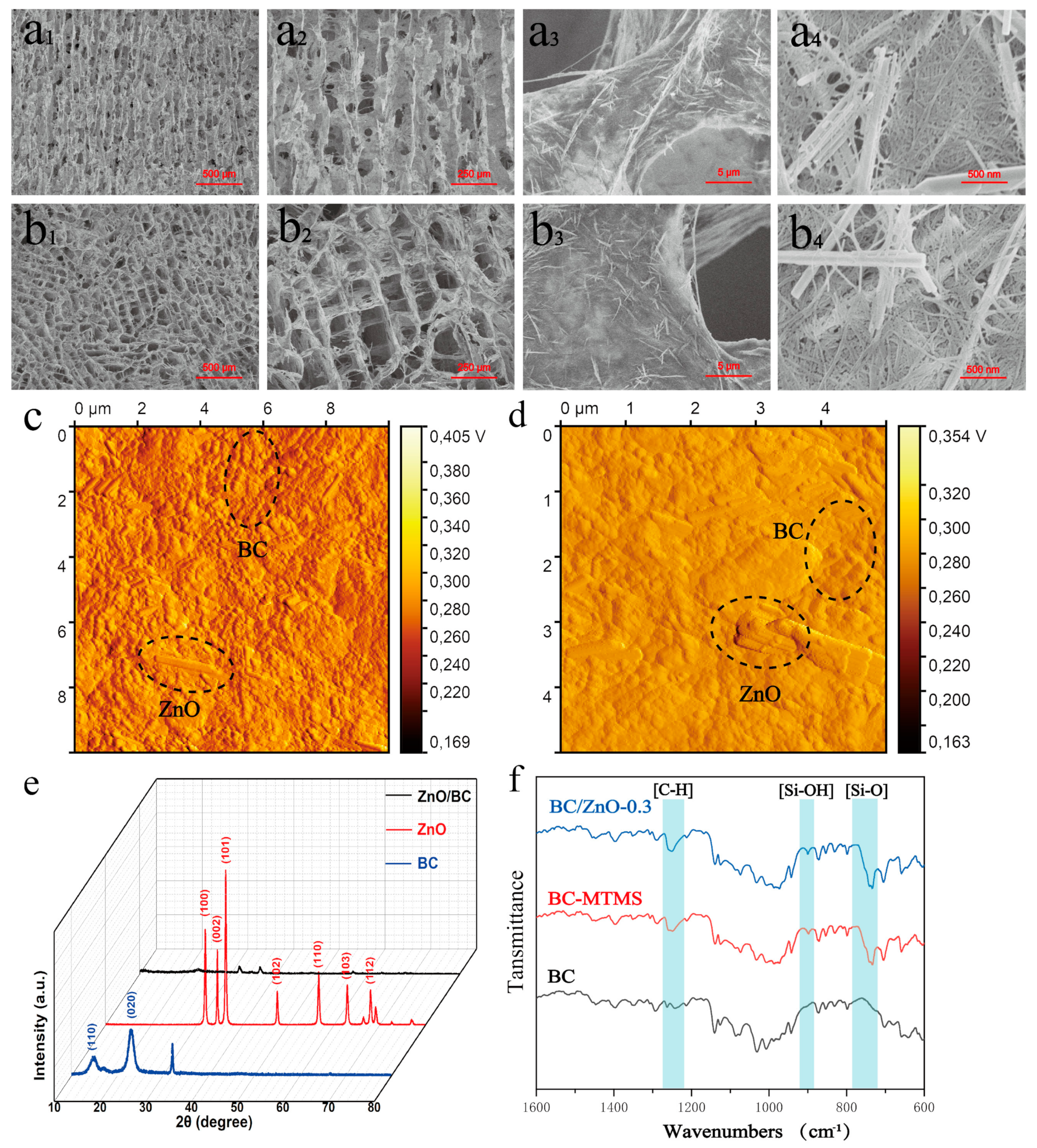

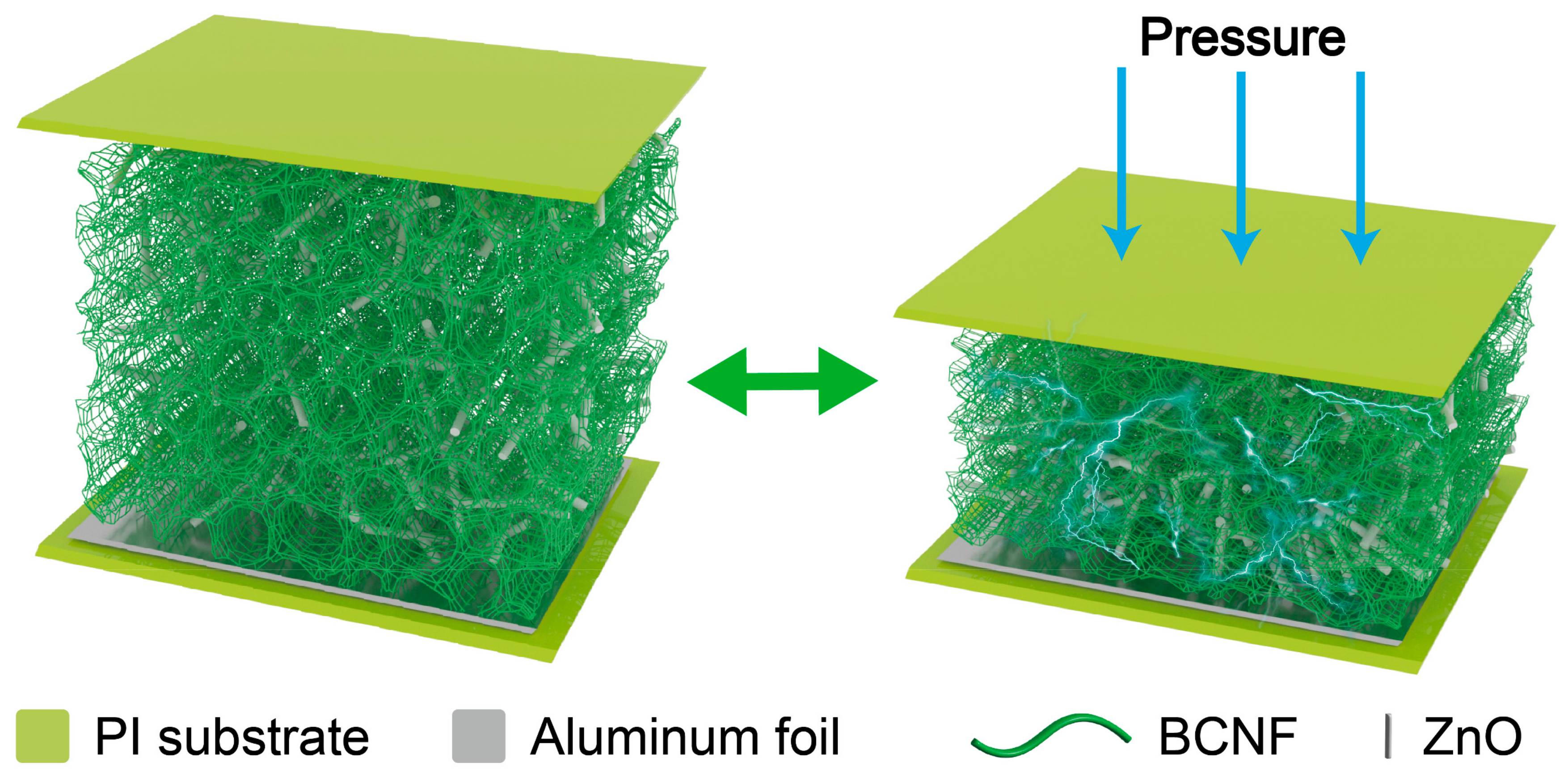
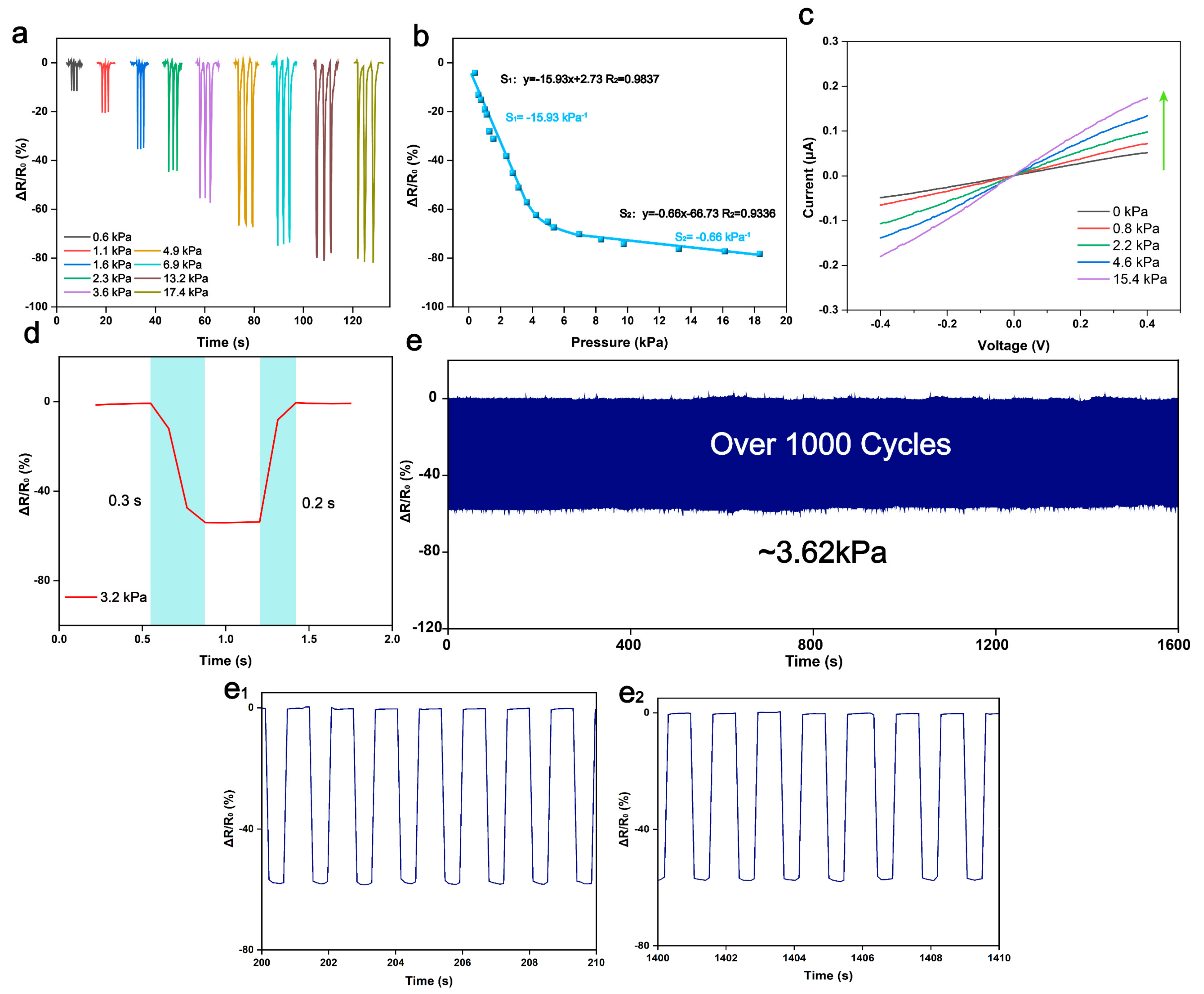


Disclaimer/Publisher’s Note: The statements, opinions and data contained in all publications are solely those of the individual author(s) and contributor(s) and not of MDPI and/or the editor(s). MDPI and/or the editor(s) disclaim responsibility for any injury to people or property resulting from any ideas, methods, instructions or products referred to in the content. |
© 2024 by the authors. Licensee MDPI, Basel, Switzerland. This article is an open access article distributed under the terms and conditions of the Creative Commons Attribution (CC BY) license (https://creativecommons.org/licenses/by/4.0/).
Share and Cite
Liu, Y.; Wang, B.; Chen, J.; Zhu, M.; Jiang, Z. Flexible Nanofiber Pressure Sensors with Hydrophobic Properties for Wearable Electronics. Materials 2024, 17, 2463. https://doi.org/10.3390/ma17102463
Liu Y, Wang B, Chen J, Zhu M, Jiang Z. Flexible Nanofiber Pressure Sensors with Hydrophobic Properties for Wearable Electronics. Materials. 2024; 17(10):2463. https://doi.org/10.3390/ma17102463
Chicago/Turabian StyleLiu, Yang, Baoxiu Wang, Jiapeng Chen, Min Zhu, and Zhenlin Jiang. 2024. "Flexible Nanofiber Pressure Sensors with Hydrophobic Properties for Wearable Electronics" Materials 17, no. 10: 2463. https://doi.org/10.3390/ma17102463
APA StyleLiu, Y., Wang, B., Chen, J., Zhu, M., & Jiang, Z. (2024). Flexible Nanofiber Pressure Sensors with Hydrophobic Properties for Wearable Electronics. Materials, 17(10), 2463. https://doi.org/10.3390/ma17102463




